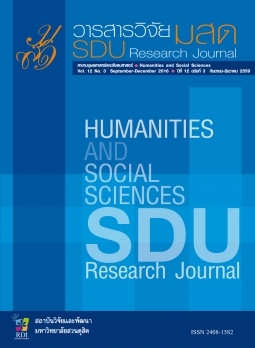จินตนาการทางวิทยาศาสตร์สู่การเรียนรู้วิทยาศาสตร์ในศตวรรษที่ 21
Keywords:
Scientific Imagination, Science Learning, 21st CenturyAbstract
Scientific imagination is an important link between imaginative thinking and
scientific knowledge which leads to the development of students’ creativity. Creativity,
certainly, is one of the essential skills necessary for the citizen in the 21st century.
However, scientific imagination is the basic ability occurred before and has a direct
relationship with scientific creativity. This article aims to present a review of literature and
knowledge related to scientific imagination in 4 main points which are the relation
between imagination and creativity, scientific imagination, the abilities of people with
scientific imagination and scientific imagination in science classroom. In science learning,
if instructors aware of the importance of scientific imagination, this will lead to the
development of the new knowledge, innovations and make science learning more
meaningful to learners .
References
พ.ศ.2545). กรุงเทพฯ: คุรุสภาลาดพร้าว.
กระทรวงศึกษาธิการ. (2555). แผนพัฒนาการศึกษาของกระทรวงศึกษาธิการฉบับที่สิบเอ็ด (พ.ศ. 2555-
2559). กรุงเทพฯ: สำนักงานปลัดกระทรวงศึกษาธิการ.
ดวงดาว กีรติกานนท์. (2557). การเสริมสร้างทักษะการใช้เหตุผลในการเรียนการสอนโดยใช้หลักการทาง
ปรัชญา. วารสารวิจัย มสด. สาขามนุษยศาสตร์และสังคมศาสตร์, 10(2), 235-252.
ฐิตินาถ สุคนเขตร์ และ วันปิติ ธรรมศรี. (2557). การประยุกต์ใช้ความรู้ทางวิทยาศาสตร์ในชีวิตประจำวัน
โดยใช้กิจกรรมสืบเสาะความรู้. วารสารวิจัย มสด. สาขามนุษยศาสตร์และสังคมศาสตร์, 10(2),
181-196.
สายพิรุณ ผุสดี. (2552). การศึกษาผลสัมฤทธิ์ทางการเรียนวิทยาศาสตร์และความสามารถในการจินตนาการ
ทางวิทยาศาสตร์ของผู้เรียนชั้นมัธยมศึกษาปีที่ 1 ที่ได้รับการจัดการเรียนรู้ด้วยหนังสือการ์ตูน
อิเล็กทรอนิกส์ (วิทยานิพนธ์ปริญญามหาบัณฑิต). กรุงเทพฯ: มหาวิทยาลัยศรีนครินทรวิโรฒ.
สิริภิญญ์ อินทรประเสริฐ. (2557). ความสัมพันธ์ระหว่างอิทธิพลของสื่อกับพฤติกรรมความรุนแรงของเด็ก
และเยาวชนในกรุงเทพมหานคร. วารสารวิจัย มสด. สาขามนุษยศาสตร์และสังคมศาสตร์, 10(3),
17-36.
อดุลย์ วงศ์ก้อม. (2544). การศึกษาผลการสอนประกอบการใช้แบบฝึกเขียนนิยายวิทยาศาสตร์ที่มีต่อผลสัม
ฤทธิ์ทางการเรียนและความสามารถในการคิดเชิงจินตนาการทางวิทยาศาสตร์ของผู้เรียนชั้น
มัธยมศึกษาปีที่ 3 (วิทยานิพนธ์ปริญญามหาบัณฑิต). กรุงเทพฯ: มหาวิทยาลัยศรีนครินทรวิโรฒ.
อรอนงค์ เหล็กกนก. (2549). การศึกษาผลการจัดการเรียนรู้ประกอบการเขียนนิยายวิทยาศาสตร์ทาง
อิเล็กทรอนิกส์ที่มีต่อ ผลสัมฤทธิ์ทางการเรียนและความสามารถในการคิดจินตนาการทาง
วิทยาศาสตร์ของผู้เรียนชั้นมัธยมศึกษาปีที่ 1 (วิทยานิพนธ์ปริญญามหาบัณฑิต). กรุงเทพฯ:
มหาวิทยาลัยศรีนครินทรวิโรฒ.
Asia Society Partnership for Global Learning. (2012). Teaching and Learning 21st Century
Skills: Lessons from the Learning Sciences. Retrieved September 15, 2014, from
http://asiasociety.org/files/rand-0512report.pdf.
Egan, K. (1992). Imagination in Teaching and Learning: Ages 8 to 15. London: Routledge.
Freedman, A. M. (2010). Inspiration, Imagination, Creativity, and Innovation. World Institute
for Action Learning. Retrieved April 4, 2014, from www.wial.org/uploads/.../
8daddac0c61262d3f21d4dfc9af45c7b.pdf.
Grant, E. (2004). Scientific Imagination in the Middle Ages. Perspectives on Science, (12)4,
394-423. Retrieved April 4, 2014, from http://www.mitpressjournals.org/doi/pdf/
10.1162/1063614042776021
Ho, H., Wang, C. & Cheng, Y. (2013). Analysis of the Scientific Imagination Process. Thinking
Skills and Creativity, 10, 68-78. Retrieved September 15, 2014, from http://
www.sciencedirect.com/science/article/pii/S1871187113000217.
Katz, D. A. (1999). Science and Science Fiction with Emphasis on Chemistry and Science
Fiction. Science and Science Fiction, National Science Teachers Association
National Meeting. Retrieved September 15, 2014, from http://www.chymist.com/
Science%20and%20Science%20Fiction.pdf.
Liang, C., Chang, C., Chang, Y. & Lin, L. (2012). The Exploration of Indicators of Imagination.
The Turkish Online Journal of Educational Technology, 11(3), 366-374.
Plait, P. (2009). Science IS Imagination. Retrieved April 4, 2015, from
blogs.discovermagazine.com/.../2009/.../science-is-imagination/.
Polk, B. (2009). Scientific Imagination. Retrieved April 4, 2015, from www.genevaschool.org/
.../11-20-09_scientific_imagination.pdf.
Samli, A. C. (2011). Chapter 2: From Imagination to Innovation: New Product Development
for Quality of Life. Retrieved April 4, 2015, from www.springer.com/cda/content/
.../cda.../9781461408536-c1.pdf.
The Partnership for 21st Century Skills. (2009). 21st Century Skills. Retrieved September 15,
2014, from www.p21.org.
Tytler, R. (2007). Australian Education Review: Re-imagining Science Education Engaging
Students in Science for Australia’s Future. Camberwell: Australian Council for
Educational Research.
Vygotsky, L. S. (2004). Imagination and Creativity in Childhood. Journal of Russian and East
European Psychology, 42(1), 7–97.
Wang, C., Ho, H. & Cheng, Y. (2015). Building a Learning Progression for Scientific
Imagination: A Measurement Approach. Thinking Skills and Creativity, 17, 1-14.
Wang, C., Ho, H., Wu, J. & Cheng, Y. (2014). Development of the Scientific Imagination
Model: A Concept Mapping Perspective. Thinking Skills and Creativity, 13, 106-
119.
Translated Thai References
Intraprasert, S. (2014). The Relationship between Media Influence and Violent Behavior of
Child and Youth in Bangkok. SDU Research Journal Humanities and Social
Sciences, 10(3), 17-36. (in Thai)
Kiratiganont, D. (2014). Promotion of Reasoning Skills in Instruction Using Philosophical
Principles. SDU Research Journal Humanities and Social Sciences, 10(2), 235-252.
(in Thai)
Lekkanok, O. (2006). A Study on the Effects of Administering Learning through Electronic
Science Fiction Writing Practice on Science Achievement and Science Imaginative
Thinking Ability of Mathayomsuksa I Students (Master’s thesis). Bangkok:
Srinakharinwirot University. (in Thai)
Ministry of Education. (2010). National Education Act B.E.2542 (1999) and Amendments
(Second National Education Act .B.E. 2545 (2002). Bangkok: Kurusapa Ladprao
Printing press. (in Thai)
Ministry of Education. (2012). The Eleventh National Education Development Plan (2012-
2016). Bangkok: Office of the Permanent Secretary. (in Thai)
Pudsadee, S. (2009). The Study of Achievement in Science and Ability in Science
Imagination of Mathayomsuksa I Students that Learning by Electronic Cartoon
Book (Master’s thesis). Bangkok: Srinakharinwirot University. (in Thai)
Sukonket, T. & Thamasri, W. (2014). The Application of Science Knowledge in the Daily Life
Using Knowledge Inquiry Activity. SDU Research Journal of Humanities and Social
Sciences, 10(2), 181-196. (in Thai)
Wonggom, A. (2001). A Study on the Effects of Administering Learning through Science
Fiction Writing Practice on Science Achievement and Science Imaginative
Thinking Ability of Mathayomsuksa III Students (Master’s thesis). Bangkok:
Srinakharinwirot University. (in Thai).








